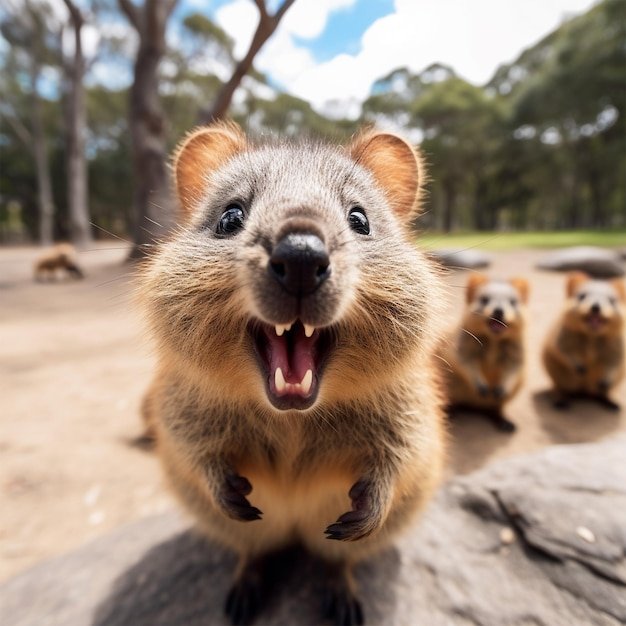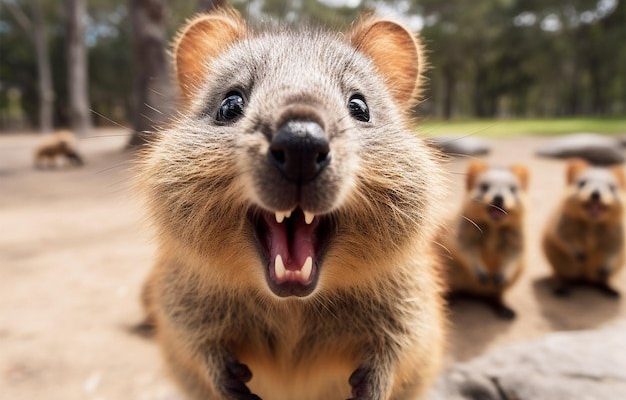
When we think about the quokka, we’re reminded of tales filled with whimsy and wonder. Whether it’s its playful nature or the picturesque backdrop of its habitat, the quokka offers rich narratives that resonate with many. So, what is it about this little creature that has inspired such fascination? Let’s dive into the cultural representations and folklore that surround this delightful animal.
Quokkas in Indigenous Australian Stories
Indigenous cultures have a deep connection to the land and its wildlife, and the quokka is no exception. Many Aboriginal groups view the quokka as a vital part of their ecosystem and storytelling. In some stories, it represents resilience and adaptability, showcasing how this small animal thrives in challenging environments.
One common theme in these tales is the relationship between the quokka and other animals. For instance, stories may explain how the quokka uses cleverness to escape predators, turning its survival into a lesson about intelligence and resourcefulness. This perspective highlights the quokka’s role not just as a creature of joy but as a symbol of wisdom in some Aboriginal cultures.
These narratives often emphasize the quokka’s vibrant community life, portraying it as a social animal that teaches us about cooperation. Just like how a family works together, the quokka shows that togetherness can make life happier and more sustainable.
The Quokka’s Social Media Fame
In the digital age, the quokka has skyrocketed to fame, thanks in part to social media. Thanks to its natural smile and curious nature, photos of quokkas have taken over platforms like Instagram. You might have even seen viral posts featuring tourists posing with these cute creatures at Rottnest Island.
This recent fame has added a modern layer to its cultural representation. Now, people worldwide associate the quokka with positivity and joy. You might wonder, how did this little animal become a symbol of happiness? It’s all about that captivating smile! People love sharing their experiences with quokkas, capturing moments that radiate happiness and connection.
Quokkas have also sparked a significant movement focused on wildlife conservation and awareness. As countless people share their quokka pics, they inadvertently promote the importance of protecting this vulnerable species and its habitat. Suddenly, a picture of a smiling quokka isn’t just adorable; it’s a call to appreciate and preserve nature.
Quokkas in Art and Literature
Art and literature have long been mediums for portraying animals in unique ways. The quokka has inspired various artists and authors, often embodying themes of happiness, innocence, and the beauty of nature. For instance, you might find colorful paintings showcasing quokkas in their natural habitats, often surrounded by lush greenery and vibrant landscapes reflecting their joyful spirit.
In children’s literature, quokkas frequently appear as friendly characters in stories aimed at teaching lessons about friendship and adventure. They serve as relatable heroes, encouraging young readers to embrace curiosity and explore the world around them. Through these stories, quokkas become not just animals but companions that invite readers into whimsical journeys.
Plus, artists often depict them in humorous situations, further cementing their reputation as joyful creatures. The portrayal of quokkas in art not only entertains but also sparks conversations about the importance of wildlife and the need for conservation.
Folklore and Mythology Surrounding the Quokka
While the quokka may not have a rich repository of ancient myths, its essence finds itself woven into modern folklore. You might hear tales where the quokka is seen as a guardian spirit of the bush, symbolizing happiness and good fortune. In these stories, spotting a quokka can be interpreted as a sign of luck, encouraging people to appreciate the small joys in life.
Some narratives suggest that the quokka possesses magical qualities, often linked to bringing joy to those who respect nature. This folklore reflects a growing understanding of the interconnectedness between humans and wildlife. The quokka’s cheerful disposition fits perfectly into narratives that teach us to cherish our surroundings and the creatures that inhabit them.
Moreover, in a world filled with stress and challenges, these lighthearted tales provide a refreshing perspective on life—emphasizing that happiness can be found in the simplest of moments, like a quokka grinning at you from the bushes.
The Quokka as a Symbol of Conservation Efforts
In recent times, the quokka has become an emblem of wildlife conservation. As it faces threats from habitat loss and invasive species, efforts to protect this delightful creature have intensified. Organizations and local communities advocate for preserving the quokka’s natural habitats, emphasizing the message that every creature plays a vital role in the ecosystem.
The popularity of the quokka has helped shine a spotlight on broader environmental issues. People rallying behind the quokka has encouraged discussions about biodiversity and sustainability. The charming images of quokkas on social media serve as powerful reminders of why we need to care for our planet.
As campaigns raise awareness, the quokka’s representation in culture evolves. It’s no longer just about being cute; it’s about standing as a beacon of hope for wildlife preservation. The strong connection between the quokka and conservation serves as a call to action for all of us to be more mindful of our environment.
The Quokka in Pop Culture
The influence of the quokka has transcended traditional representations and settled into pop culture. From animated films to merchandise, this little marsupial is capturing hearts everywhere. You might find quokka toys, clothing, and even stickers, which not only celebrate the animal but also spread the message of conservation.
In films and television shows, the quokka often appears as a background character, symbolizing joy and the beauty of nature. These representations help introduce the quokka to audiences who might not be familiar with it, further fueling its fame. The more people see and talk about quokkas, the greater the community of advocates it creates.
This blooming pop culture status is vital, as it helps bridge the gap between wildlife and the average person. When someone wears a quokka-themed shirt or shares a meme featuring one, they’re not just having fun—they’re also spreading awareness about this unique creature and its place in our world.
The quokka, with its endearing charm and friendly personality, plays a significant role in various cultural narratives and folklore. From Indigenous Australian stories that highlight its wisdom to the modern social media fame that promotes conservation, the quokka represents so much more than just a cute face. It symbolizes happiness, resilience, and our connection to nature.
As we celebrate the quokka and its cultural representations, let’s remember the lessons it teaches us. Whether through art, stories, or social media, the quokka reminds us to embrace joy, appreciate our surroundings, and work towards protecting our planet. So, the next time you see a quokka’s beaming smile, take a moment to cherish not just its beauty but also the rich tapestry of stories and meanings it brings into our lives.

